|
Living
Dangerously
(A Virgin in the Forest)
INTRO - Editor
'arris
As a last CMG-RC
event of the 2001 season, we decided to do a day at the Trail Tours
School, in the Ganaraska forest, located in south-central Ontario. One
of the accompanying riders was Seymour Trachimovsky. Thankfully, Seymour
took it upon himself to write up his experiences, thus allowing me to
put all note-taking requirements aside, and just focus on just having
a good ride.
So, without further
ado, let's slap on our body armour, tight fitting clothing, menacing
boots, and head for the hills!
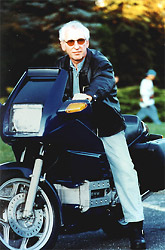 |
| Seymour
on his 'usual' ride. |
For those of you who care
to live dangerously you can try the FAST school. But if you really want
to live dangerously, really, really, try dirt biking. I tried it and
I'm alive to tell you about it but for more than just a few moments
on a beautiful crisp autumn day in the Ganaraska Forest I was beginning
to doubt it.
I tried it at the invitation
of Rob Harris "Grand Fromage" of CMG online, who had organised
the trip as one of the CMG Rider's Club events.
Most of us drive down on
two wheels or four the night before, staying at the Sandringham B &
B in Bethany, Ontario. Saturday morning we all collect at a parking
lot just off Highway 115 where we are met by a kid on a dirt bike who
escorts us the last ten or fifteen miles to the base camp (yeah, the
"base camp").
When you arrive at the base
camp you are asked to sign a waiver of course. Steve, the kid who owns
the business may be a country boy but he ain't stupid. He had one
of the best-worded waivers, from a professional point of view, that
I have ever seen including an indemnification provision that basically
said if you're stupid enough to try this sport even after we have
expressed our misgivings to you and recommended strongly that you would
be best advised not to even think about doing this, you will hold us
harmless against any damages you will certainly incur. That meaning,
however, was not revealed to me until about six hours later. Initially
the actual legalese seemed merely curious.
 |
| Ready
to go. |
After being processed into
two roughly equal-sized groups, one for experienced or modestly-experienced
riders and another for the inexperienced, we were told that after lunch,
there would be further segmentation. As I later learn, they know their
customers. Then we geared up.
The gear gives you a hint
of what's to come and it's here where you have the first opportunity
to begin to focus on what the next few hours will have in store for
you. You get knee pads, shoulder pads, elbow pads, hip pads, chest protector.
This, I'm thinking is for riding a motorcycle? Hey, cool, we're
probably going to play hockey before we go out on our bikes. I still
wasn't getting it.
The next thing is we're
introduced to our bikes, Yamaha, Suzuki or Kawasaki, 200-250cc. I learn
later that the bikes are provided by the manufacturer gratis. However,
at the end of the season, they're supposed to be returned in "showroom
condition".
Given the abuse these bikes
take at the hands of people like myself over the duration of a season,
the only way this can be accomplished is by replacing new plastic with
used when the bikes are received at the front end of the season, reversing
the process at the end of the season. The 200 dollar price of the course
is a bargain and would be a whole lot more in the absence of this corporate
largesse.
We ride them around a makeshift
forest course for a little while to get the hang of it. Of eleven riders,
three take tumbles, a couple run into trees. This is in the first ten
or fifteen minutes on a simple practice course.
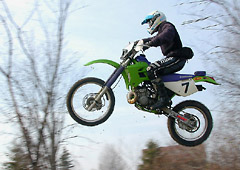 |
| You
can't do that on a Gold Wing! |
It's a strange bike with
no creature comforts. No Goldwing luxuries, that's for sure. This bike
is like a kid from a New York ghetto, wiry and full of bravado, seriously
tough with a take-no-prisoners attitude compared to a Goldwing which
would be analogous to a fat wealthy banker.
Steve reads us the rules
for ten or fifteen minutes, warns us of dangers in the woods - other
bikes, horses, bicyclists - and instructs us in the protocols if you
encounter them.
"They hate us",
he remarks viscerally slowly shaking his head, looking hurt. I assume
he's referring to the tree huggers and many others who for some
reason don't believe the dulcet purr of internal combustion engines
is compatible with the sylvan beauty and peace of the woods. Because
they hate us, he asks us to be deferential to them, to kill the engines
when we encounter riders or horses, to say something sweet. "Hi.
Nice horse. Really well-hung." Hell, bikes are as much a part of
nature as bear scat.
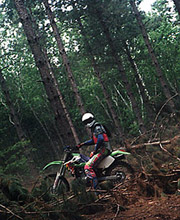 |
| Getting
lost in the Ganaraska. |
Finally, if you get separated
from the group, stay where you are. Do not try to find your own way
out. The Ganaraska Forest is a 14,000 acre private forest area containing
approximately 500 miles of trails and it ain't laid out in an urban
square grid. It wouldn't take more than 60 seconds deviation from
a trail to get hopelessly lost. By the end of the ride, I still had
no idea how our guides were able to negotiate this mostly unmarked maze
of trails.
Then we are off, down a pleasant
somewhat narrow dirt road. After five minutes, Steve signals his arm
right and we are suddenly in the woods. Now the riding starts to get
interesting. Things are coming at you from all directions, right, left,
up, down, trees and tree stumps, rocks, leaves, ruts, broken and low
hanging branches. The trail narrows from three feet to one foot, there
are sharp corners and hairpins, surface is all over the map, from hard-packed
dirt to beach sand. Changes in topography are sharp and come upon you
abruptly, without warning.
Techniques that are de rigueur
on the road, such as counter-steering, do not necessarily work in the
dirt. Taking curves properly requires you to get right up there with
your crotch on the gas tank, shifting weight to the front wheel and
off the rear. No passing. Elbows held high and wide to avoid putting
excessive pressure on your wrists which could result in a nasty wrist
break when you collide with a hidden boulder. Most of the time, proper
technique requires the rider to stand on the pegs, straight-legged.
He might have added a couple of things about proper braking and gear
shifting, I'm thinking a little later as I'm lying flat on
my back on the forest floor.
The event in question was
just 10 or 15 minutes into the ride. After the initial gnarly bit, the
trail opened wide and I breathed easily for a few moments. Not so fast
Trachimovsky!
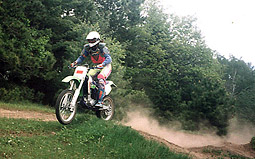 |
| Editor
'arris shows how to do the "whoops" like a wimp. |
Seconds later I am rolling
way too quickly down a steep winding sandy hill. A third of the way
down the hill, there is a sharp downhill right-hander through sand.
In a moment I am on my ass, the bike on top of me. We right the bike
but it is not just my feelings that are bruised. I am bruised, my back,
my legs, and 'elsewhere' as well.
We soldier on. Every pathway
has its own unique characteristics and challenges, steep uphill portions,
steep downhill portions, huge water-filled mud puddles and, of course,
"the whoops" - an extended sequence of huge bumps on the trail
which severely test the bike's and your own suspension.
Experienced riders will joyfully
take these airborne. I am not so joyful. The bikes take a severe pounding.
They are all torque, suspension and guts and will get you out of any
jam if you let them but you have to know how to let them. Going through
a thirty foot long mud puddle, your wheels in mud up to the axle, is
an experience. There were dozens of mud puddles and you best not slow
down.
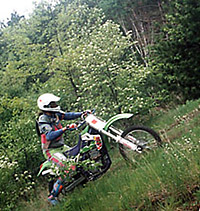 |
| Trying
the hill climb. |
An hour or so later, I am
once again on the ground, this time testing the strength of my helmet.
This time it wasn't even a challenging spot, just a bit out of
control and a spot of panic, locked up the front wheel. Plop. Minor
bruises.
Then it's back to base camp,
for a relatively decent lunch. After lunch Steve asks if there is anyone
who would like to ease off a bit in the post-prandial ride. I have been
waiting for this moment and immediately volunteer, the only one as it
turns out to be begging for mercy.
So now it's just me
and Guy, one of the staff riders, private lessons. Soon we are off down
a pleasant open trail at a moderate pace. Suddenly, we are on a trail
fit only for a mountain goat. This is easing off? At lunch time I had
quipped something about "good thing they didn't take us on
tough trails this morning". Little did I know how right I was.
I thought I had seen everything
when my guide paused to describe the hill we were about to descend.
Pure beach sand, precipitous decline, two or three hundred meters. "Drag
the rear brake, do not use the front brake", he says. After a pathetic
attempt at this technique, I end up inching downward dragging the only
brake I can control, my two feet.
Ten minutes and a few hundred
other challenges later we are climbing the steepest winding embankment
I have ever seen. It felt like riding straight up the CN Tower. If you
don't have enough power, you're going all the way back down,
dead or alive. Fortunately, that mountain goat of a bike got me there,
the old forest ranger's tower location, my heart in my mouth.
For about two hours until
3:30, six hours after we arrived, including three or four stops, we
rode on trails that in many cases weren't even identifiable as
trails, more a random walk through the forest. The leader was performing
incredible feats, including wheelies over the whoops. I was scared to
death and having a blast.
By the end of the day almost
everyone had taken a plunge or two or three. There were some funny stories,
but the thrill was universal. It would be hard to match the rush, but
this is a sport only for the young or young at heart - like riding a
bucking bronco or, as one guy put it, doing fifteen rounds with Mike
Tyson.
Back at the B&B, six
of us with the help of dazzling Daniela, Rob's squeeze, polished
off two dozen beer and the equivalent of two bottles of scotch and told
tall tales. We'd have drunk more but the LCBO is not open at 12:30a.m.
That night I slept like a
baby, and dreamt of being chased by trees.
Seymour
Trachimovsky
|
![]()
![]()